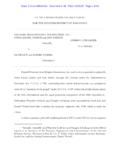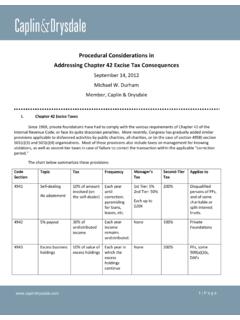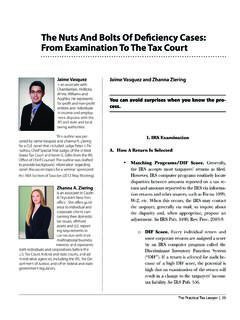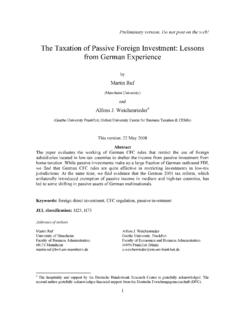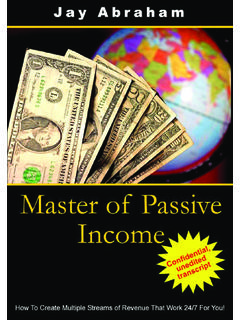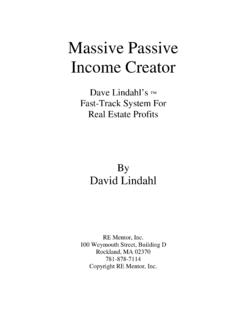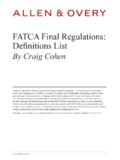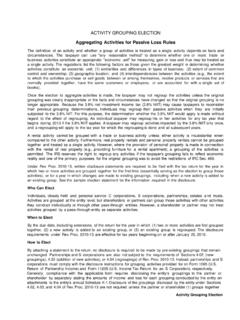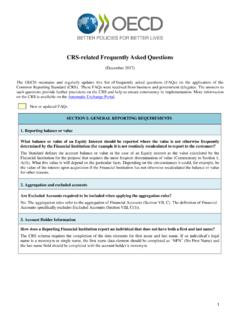Transcription of INTERNATIONAL DEVELOPMENTS Taxation of Passive …
1 INTERNATIONAL DEVELOPMENTST axation of Passive Foreign Investment Companies: Current Rules, Problems and PossibleSolutionsLUCY S. LEE AND STAFFORD SMILEYSTAFFORD SMILEY is Professor, Graduate Tax Program, at the Georgetown University LawCenter. LUCY S. LEE is a Member of, and Professor Smiley is Senior Counsel to, the law firmof Caplin & Drysdale, Chartered, Washington, DC. The authors wish to express theirappreciation for assistance rendered by Noam Noked, a summer intern at Caplin & Drysdale in2011 and an student at Harvard Law article was published in the November/December issue ofCorporate Taxation .
2 2011 Thomson Reuters/WG& United States has for many years taxed certain shareholders of closely held orcontrolled foreign corporations deriving principally Passive or related-party income on their prorata share of the corporation's earnings whether or not distributed. These rules are commonlyreferred to as anti-deferral provisions and are contained in the Code. The primary anti-deferral provisions for corporations are the controlled foreign corporation (CFC) rules and thepassive foreign investment company (PFIC) principal benefit associated with the use of foreign corporations is the deferral taxes on the foreign source income of a foreign corporation until it is repatriated to a to 1/1/06, there was a third set of rules known as the foreign personal holding company(FPHC) rules.
3 However, Congress felt that because income that would have been taxable underthe FPHC rules may also have been taxable under the rules governing CFCs or the PFIC rules,there existed unnecessary and confusing overlap. Accordingly, Congress eliminated the FPHC rules in in the form of a dividend the potentially unlimited duration ofthe deferral privilege, Congress was concerned that certain kinds of income could escape forever because there would never be a need to repatriate the income . Moreover, shareholders sold stock in the foreign corporation to raise cash in the United States insteadof taking dividends, they could potentially convert the foreign corporation's ordinary income tocapital gains subject to preferential tax rates.
4 Congress enacted the CFC rules in 1962 tocurrently tax owners of certain foreign corporations on their pro rata share of certain typesof income earned by the foreign corporation--generally speaking, income that could be easilyshifted from the to an offshore tax haven, thereby obtaining tax deferral. 3 The CFC rules were designed to apply on the basis of majority ownership (or atleast 10% ownership on an individual basis), but Congress eventually came to feel that thislimitation left a loophole that allowed taxpayers to enjoy the benefit of deferral by takingminority ownership positions in ( foreign ) mutual funds expected to accumulateearnings rather than make annual distributions of income .
5 Congress enacted the PFIC provisions as part of the Tax Reform Act of 1986 to reduce the ability of persons to defertax in this way and thereby to equalize the treatment of foreign and investment the PFIC rules originally targeted persons' investments in offshoremutual funds, the scope of the rules as enacted is broad and can capture a vast universe ofinvestments in offshore companies and investment vehicles. The rules can apply to any that own an interest in an offshore subsidiary whose assets or income is generallypassive.
6 As noted above, there is no minimum level of stock ownership required by a S. Rep't No. 1881, at 87-88 (1962), reprinted in 1962-3 CB 707, 794; H. Rep't No. 1447(1962), reprinted in 1962-3 CB 405, Report No. 1447 (2 out of 5), 87th Cong., 2nd Sess., 1962-3 CB 405 (3/16/62).person to be subject to the PFIC rules and therefore even foreign public companies can beconsidered PFICs for tax purposes. Thus, even a small percentage of ownership can resultin severe tax and reporting consequences. Both the CFC and PFIC rules look not only to directownership, where shares of foreign corporations are owned outright by a person, but alsoto indirect ownership through foreign corporations, partnerships, trusts, and estates and takeinto account certain attributed ownership from certain related persons (althoughattributed or constructive share ownership does not generally lead to income inclusion).
7 This column is designed to provide a general overview of the substantive rulesregarding the Taxation of interests in PFICs, including the excess distribution regime, thequalified electing fund regime, and the mark-to-market regime. In addition to the substantiverules, there are significant record-keeping and reporting burdens placed on shareholders ofa foreign corporation that is a CFC or PFIC. The record keeping and reporting obligations arenot discussed in this paper, but the authors would like to note briefly that with regard to PFICs,each shareholder of a PFIC must file a Form 8621, Return by a Shareholder of a PassiveForeign Investment Company or Qualified Electing Fund, to report distributions from or salesof interests in a PFIC, or to make certain elections.
8 There may be additional filing requirementsdepending on transactions occurring between the shareholder and the foreign company( , Form 926, Return of a US Transferor of Propertyto a Foreign Corporation, to report transfers of property to the foreign corporation).Following a general discussion of the substantive rules, this column identifies certainareas of challenges in the current rules and proposes some preliminary thoughts on potentialways to improve the current of a PFICA foreign corporation is treated as a PFIC for a tax year if.
9 (1) at least 75% of the corporation'sgross income for the year is Passive or investment-type income ( income test ), or (2) at least50% of the average fair market value of its assets during the year are assets that produce or areheld for the production of Passive income ( asset test ).4 For purposes of these tests, passiveincome generally includes any income item meeting the definition of foreign personal holdingcompany income as defined in Section 954(c), which generally includes, among others,dividends, interest, and net gains from the sale of stock or interests in a trust, partnership, is a "look-through" rule that treats the assets and income of a second-tiersubsidiary as being directly owned by the foreign corporation being evaluated for PFIC status,but it applies only to corporations that are directly or indirectly 25% or more owned by thecorporation being.
10 All of the income earned by a holding or investmentcompany will most likely be Passive income , and the company will qualify as a PFIC can be organized as a corporation or unit trust but generally is taxed the same ineither event. PFICs are generally marketed by large foreign financial institutions, includingbanks and money managers. For example, UBS, Credit Suisse, Pictet, HSBC, Barclays,Mercury Asset Management, Global Asset Management, and so forth, market PFICs. MajorEuropean and Asian papers, including the INTERNATIONAL Herald Tribune and Financial Times,frequently carry daily or weekly lists of such funds, quoting their current "net asset values.
